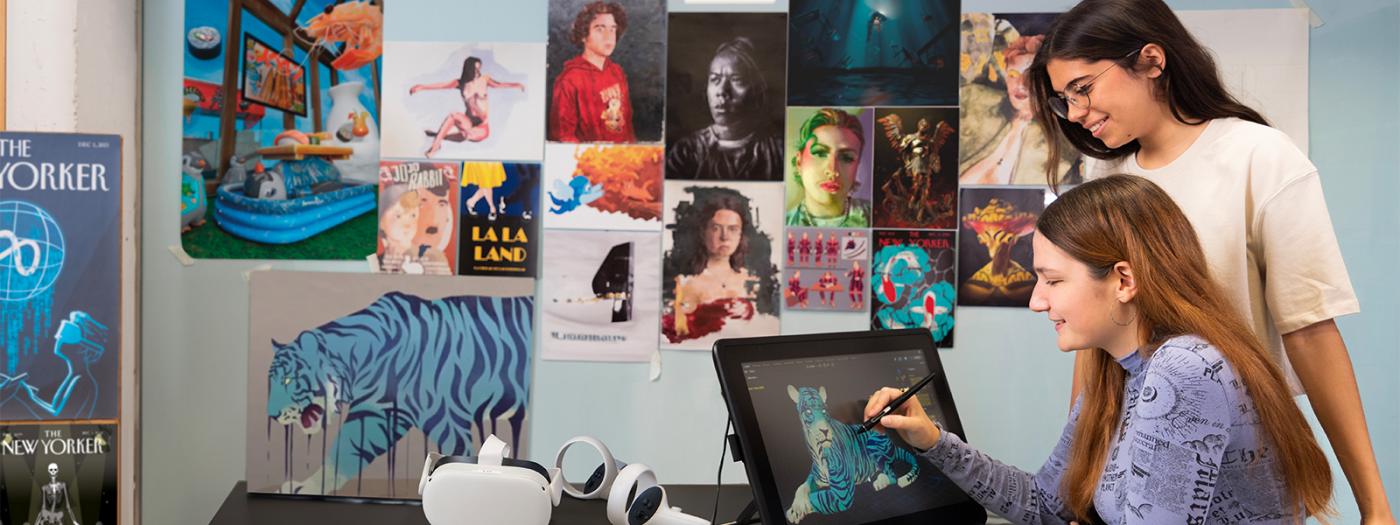Titular Professors
Learning Outcomes of this subject are:
RA143 The student will be able to create complete creative digital illustration projects.
1. Introduction to illustration
What is illustration, what is it like to be an illustrator and what is currently happening in the world of illustration. What
is the difference with a concept artist.
2. Introduction to vector illustration with illustrator
Vector style will be introduced, and Illustrator will be taught how to use the program.
3. Pattern
We will explain what they are, what are their uses, and we will explain Illustrator and Photoshop tools to create your
own patterns. We will also teach referents in this field.
4. Advertising illustration
What is advertising illustration, what are its characteristics. Visual references of this field will be analyzed. This
knowledge will have to be applied to a project.
5. Press illustration
What is press illustration, what are its characteristics. Visual references of this field will be analyzed. This knowledge will
have to be applied to a project.
6. How creative ideas are generated
We will work on dynamics to exercise creative connections. Both from texts and from narrative exercises. To be able to
apply it to the projects of the subject.
7. Visual rhetorical figures
What they are and how rhetorical figures can be used to create attractive and understandable visual narratives. To
achieve much deeper and richer illustrations of meaning. These concepts will be applied to illustrate print and poetry.
8. Experimentation with analog techniques
We will experiment with different analogical techniques to explore new creative possibilities both plastic and
conceptual.
9. Process of digitalization of analogical pieces
How to digitize correctly the analogical pieces and make collages with digital techniques with Photoshop.
10. Review of layout with Indesign.
The basic layout tools of indesign, design and typography will be reviewed
The course will work through different teaching methodologies. There will be a lecture part in which the
teacher will introduce certain concepts, which will be combined with discussion classes and analysis of visual
references. In order to achieve these concepts, students will develop artistic projects where they will apply
the knowledge explained during the semester.
MD 1: Master Class with the support of audiovisual material.
MD 2: Exercise classes.
MD 3: Project-based learning.
MD4: Seminar
MD7: Flipped Classroom
Standard evaluation:
The course has two evaluative parts:
- Class participation and visual diary (moderately significant).
- Projects (highly significant)
To pass the course it will be necessary:
- Participate in class discussions, make oral presentations, and complete the visual diary.
- Turn in all projects and that they have a minimum grade of 3.5 for the subject to be evaluated.
Grades:
- Pattern project: 20%.
- Advertising project: 20%.
- Press project: 20%.
- Poetry illustration project: 30%.
- Visual diary 10%
Copy regulations:
Following the university's copy policy, the following are considered:
- Highly significant elements in the evaluation: Projects
- Moderately significant items: Visual diary
Limitation and/or prohibition of AI tools: The use of AI is forbidden in this <course/teaching activity>. Thus, the use of
these tools by students will be considered fraud and will involve the application of the copy regulations of La Salle
Campus Barcelona
Special evaluation:
Students who do not pass the ordinary assessment must re-deliver the failed exercise or project in the extraordinary assessment
session
Criteria for standard and special evaluation:
In order to evaluate the projects, experimentation and originality, coherence, adequacy, final result and good
presentation will be taken into account.
The exercises or projects that do not present a correct written, grammatical and orthographic expression or a good
structuring of the document, or do not include a consulted bibliography, will be evaluated with a maximum grade of 4.
If the conditions for passing the exam are not met, the maximum grade will be 4.
You will have the right to review the grade of the projects on the day fixed by the teacher. In this review the student's
grade can be raised or lowered.
All the recoveries will have a maximum grade of 5.
The grade of the projects approved in the ordinary exam will be kept.
- Zeegen, Lawrence. What is Illustration? First Edition, Rockport Publishers, 1 Agugust 20029.
- Zeegen, Lawrence. Principios de ilustración. Traduida por Silvia Pujol, Segunda edición, Editorial Gustavo Gili, S.L., 2013.
- Royo, Javier (2023). Dibujo, luego pienso. Lumen.
- Rodari, G. (2002). Gramática de la fantasía: Introducción al arte de contar historias. Editorial Booked.
Prensa
Bru, Ío (2019). Mis primeros pasos hacia la ilustración editorial y de prensa. Ilustrando dudas.
https://ilustrandodudas.com/articulo/mis-primeros-pasos-hacia-la-ilustra...
Publicitat
APIC associació professional d?il·lustradors de Catalunya (2021) Monogràfic publicitat (Video) Youtube.
https://www.youtube.com/watch?v=jIaedlTjao8&t=1s
